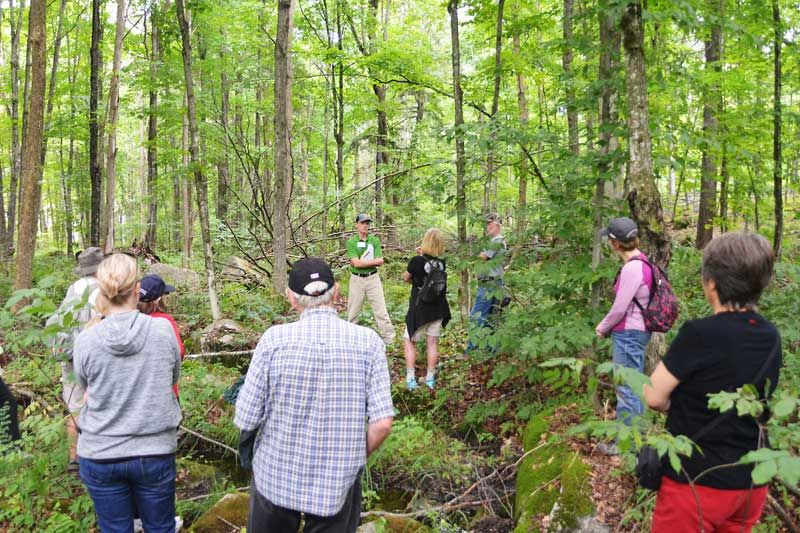Jeff Green | Aug 26, 2015
The name of the company, Mazinaw-Lanark Forest Incorporated (MLFI) sounds like it might have come from corporate Toronto, but the company owners and staff are more comfortable in the deep bush than in the corporate backrooms.
Made up of family owned logging companies, sawmill operators and Norampac, a pulp mill in Trenton, MLFI oversees harvesting activities on Crown forests in Addington Highlands, North Frontenac and northern Lanark County, a million hectare territory of which 306,000 hectares are Crown land. The productive land base that MLFI manages is 109,000 hectares, and its members harvest less than 1% of the managed forest in an average year.
Some of MLFI's main functions are to prepare and ensure compliance with a 20-year forest management plan that is approved and audited by the Ontario Ministry of Natural Resources. The plan is updated on a regular basis, the latest update being completed in 2012.
Last Friday, August 21, MLFI invited members of the public to a tour of some of the forest it manages in the area of Machesney Lake, north of Cloyne.
The tour was structured around three sites where cutting has taken place in recent years, each of them examples of the three kinds of harvesting MLFI members engage in.
Based on the principles of Silviculture (the practice of controlling the establishment, growth, composition, health, and quality of forests to meet diverse needs and values) MLFI foresters use selection 40% of the time, shelterwood 45% of the time, and clearcutting 15% of the time.
The first site visited was a Selection cutting site, which had been last cut about seven years ago. The only obvious remaining signs that the cut had taken place were some piles of brush in varying states of decomposition in the area.
Jan Smigielski, silviculture forester with MLFI, described the site and answered questions from the 30 or so participants in the forestry day.
The site contained a mixture of young, middle aged, and older trees, all indications of what is called an uneven aged forest system. This technique is suitable for harvesting sugar maple, beech, basswood, black cherry, ash, and other species. The stands are harvested in 20- year intervals and through management the proportions of the forest remain stable, with the target species gaining from each cut for commercial and environmental reasons.
“Other factors, such as wildlife preservation, not interrupting water courses such as streams, maintaining heritage and habitat trees, etc. are also taken into account by the tree markers who mark trees for removal and the foresters themselves,” said Smigielski.
The second stand that was shown is a Shelterwood stand, which was located on higher ground. Shelterwood cutting is a phased cutting program, requiring two or three separate cuts over a number of years. One of the goals of this cutting system is to encourage habitat for certain species that can grow under moderate shelter conditions, such as white pine, red oak and yellow birch, as well as mixed hardwoods.
The idea behind Shelterwood is to open up the forest to more light in order to encourage certain species. In some cases, the forest is regenerated through seed production and in some cases seedlings are planted. The stand that was used for demonstration purposes included a number of red pine seedlings.
“In general, natural regeneration is preferable,” said Smiegelski, “but as you can see, plantings have their place as well.
The final location on the tour was a Clearcut site, which is now filled with young poplars.
“Typically we clearcut small sites in order to encourage shade-intolerant species such as poplar, white birch, jack pine, spruce and red pine. You can see here how the poplar have taken to the site. They need full sun to do this,” he said.
Among those taking the tour were Amp and Wayne Snider, who both come from multi-generational logging families in the area, and are members of MLFI.
Amp Snider had done a lot of the work on the Shelterwood site that we visited on the trip, and imparted some of his hard-earned knowledge of how the forest reacts to logging.
“The ministry (MNR) has certain ideas about what is here, but we find that on the ground the situation is different. That's why our tree markers, and the members who do the work are all taking stock and evaluating what they find every day before they do anything,” said Tom Richardson, the General Manager of MLFI.
The forest that MLFI manages is the southernmost crown land managed forest in Ontario, and it features the most diverse population of trees and wildlife in any of the crown forests in Ontario, being part of the Frontenac Spur of the Canadian Shield.
“We know what we have here, and we are careful to manage it for the future,” he said, “but as you can see, it is a complicated process.”
“We have learned a lot about the forest, but it has been here for longer than we have and there are things such as soil composition, terrain, and relationships between different plants and animals that we are only starting to figure out,” concluded Jan Smigielski.
Information about the operations of Mazinaw-Lanark Forest Incorporated is available at their comprehensive website MLFI.org, which contains links to their current forest management plan. They can also be reached by phone at their office in Cloyne at 613-336-0816.
More Stories
- Sticker Shock - EV Charging Station To Cost North Frontenac Township
- 30th Anniversary Verona Car Show
- The Forgotten Comfort Veg - Eggplant
- MERA Stage Comes Alive This Fall
- North Frontenac Council Report - August 27
- Addington Highlands Council Report - September 2
- Here's Grief - Have You Met
- Burn Ban Off in North Frontenac, Addington Highlands - Reduced to Level One in South and Central Frontenac
- The Resurgent Sharbot Lake County Inn and Crossing Pub
- Towards Then End of Trail

